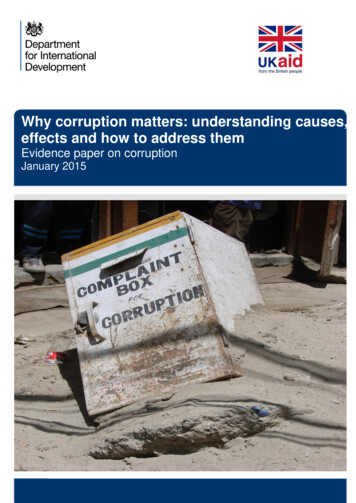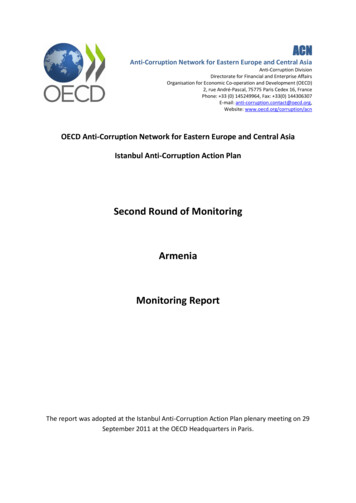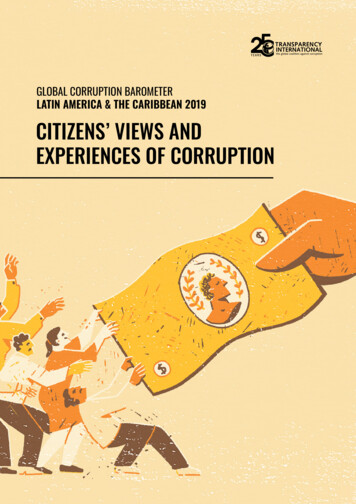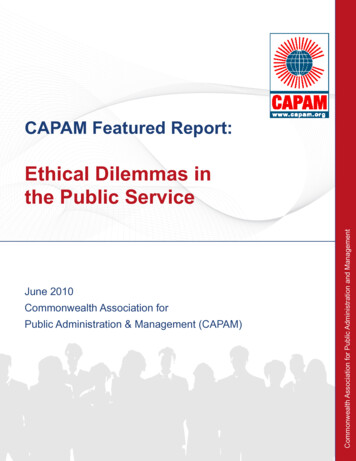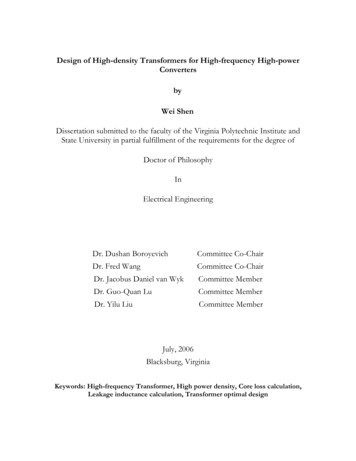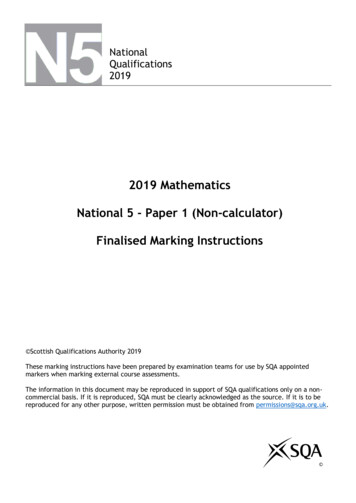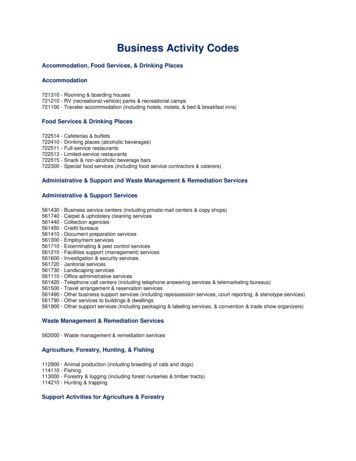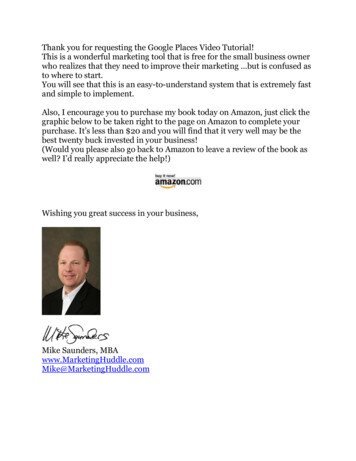
Transcription
Corruption inHigh Places
To my wife Gloriaandthe late Paul Flannery
Corruption inHigh PlacesThe key witness in the Justice Murphyscandal gives his side of the storyClarrie Briese
ContentsxiForeword by Angela KarpinxiiiAbout the authorxvAcknowledgementsPreface: Extracts of encouragementxviiPart 1: IntroductionCould it really be?NSW corruption — a bipartisan matterLetter from Senate Select CommitteeBombshell phone tapsWhy didn’t Briese report this previously?Another judge has the same experienceDisturbing phone calls from ‘George’Encouragement to press on regardlessThe cost of coming forward12346991213Part 2: The Age tapesEmergence of The Age tapesPremier Wran’s protectionBriese obtains transcripts of The Age tapesProposed meeting of Briese with Murphy and RyanFurther references to BrieseSenate Committee inquiry impedimentThe Age tapes are adjudged to be genuineVisit to former Royal Commissioner Stewart1517192126283032Part 3: Briese learns how court corruption worksFarquhar’s ‘farewell’ dinner party at Ryan’s homeWalker’s advice regarding Cessna/Milner casesProsecutor Evans — a delayed but key testimonyRole of Police Commissioner in Cessna/Milner casesFarquhar: ‘Don’t tell anyone about the dinner’Farquhar and the Cessna/Milner casesOther controversial court cases involving Farquharvii35445051525355
Part 4: Judicial independence for magistratesStruggle for judicial independence beginsMurphy engineers first meeting with BrieseResistance from the Justice DepartmentPremier Wran — supportive, but .‘Coded’ messages from Premier WranThe Local Courts Act 1982Independence for magistrates delayed61636768697173Part 5: Lead up to Murphy & Foord trialsRyan’s home searched by policeMurphy engineers second meeting with BrieseBriese visits Murphy in CanberraMurphys dine at my home with ‘phantom couples’One ‘casserole’ or more?Phone call from Murphy after the dinner‘The little fellow will be shattered’‘And now, what about my little mate?’Foord also approaches Briese about the Ryan caseWhy not report the Foord matter earlier?Developments regarding the Committee hearingsThe Inquiry by Solicitor-General GaudronAttacks by Premier WranReport by first Senate Select CommitteeAttacks by MurphyTurnbull goes to town on my evidenceSecond Senate Select Committee establishedApproaches by McClelland and Murphy to StauntonNo-bill application by Morgan RyanMurphy and Foord approach Flannery as wellMurphy engineers meetings with FlanneryFlannery’s crucial decision to come forwardStaunton tells me of ‘help coming’Further attacks by Premier WranReport by second Senate Select CommitteeWhy did Flannery not report earlier 0136137143146147161166166170175
Part 6: Neville Wran & the Street Royal CommissionFour Corners TV repercussionsShock statement by dismissing magistrateRoyal Commission looks into Farquhar and WranRole of Chief Justice StreetFresh evidence in the Humphreys case179181182187190Part 7: Murphy & Foord trialsCharges laid against Murphy and FoordFirst Murphy jury trialVerdict of guilty by the first juryStrong, unlawful attacks on Murphy’s guilty verdictTurnbull’s analysis of Murphy chargesFoord’s jury trialMurphy’s defence team appealsWran’s reaction to quashing of verdictThe Premier asks to meet meSecond Murphy jury trialNo criticism of second jury’s not guilty verdictWran turns up the heatSupreme Court Justices write in defence of BrieseAttacks cease, Wran resignsFurther allegations against Murphy emergeThe end 9275Part 8: BiographiesClarence Raymond BrieseLionel Keith MurphyPaul Francis FlanneryJohn Murray FoordMorgan John RyanMurray Frederick Farquhar279282285287289291Concluding remarks295Timeline of significant events297Appendices311ix
Foreword by Angela KarpinThis book deals with an historical incident bearing on social history and jurisprudence. It is a work of considerable importance,written by the Chief Magistrate at that time — a man well known forhis learning and thoroughness.This is a comprehensive account written with simplicity and clarity.It is a compelling account of a scandal in high places which shocked thelegal and judicial systems. It is also a detailed record of how an honestjudicial officer handled it.Mr Briese provides a detailed and intimate record of his own partin the events at the core of the book, together with a well-researchedaccount of other relevant evidence. It provides a unique insight intothose events, of special significance to all those with an interest in therule of law and social history.This is an immensely valuable historical account which must serveas a reminder of the vigilance required to maintain the integrity of ourlegal system, a vital arm of our democracy.Angela Karpin became a magistrate in 1985. She was appointed DeputyChief Magistrate in 1988, and in 1991 she became the first magistrate inNew South Wales to be appointed a District Court Judge.xi
Illustration by Bill Leak
About the authorClarence (Clarrie) Briese (1930–), BA (USyd), Diploma ofCriminology (Cantab.), AO, commenced work as a courthouseclerk and was admitted as a barrister1 in 1961. In 1966 he was appointeda Stipendiary Magistrate. After attending night lectures at SydneyUniversity, he graduated in 1972 with majors in Government andEnglish Literature.In 1976 he was awarded a Winston Churchill Fellowship for thedual purpose of studying for a Diploma in Criminology at CambridgeUniversity (awarded in 1977) and researching alternatives to imprisonment in the UK, working from Birmingham University. Upon hisreturn to Sydney he was appointed to chair a government committeewhich explored the feasibility of a Community Service Order (CSO)scheme such as he had examined in the UK. This led to the implementation of a CSO scheme in New South Wales (NSW).Clarrie was appointed Chairman of the Bench of StipendiaryMagistrates of NSW in 1979, then with the commencement of the LocalCourts Act 1982 (NSW)2 on 1 January 1985 became Chief Magistrateof NSW. Upon retiring from this position in 1990, he was appointeda Commissioner of the NSW Crime Commission, where he remainedfor six years.1The formal description of the admission was as a non-practising barrister; the admissionexamination requirements are the same as for a practising barrister.2Hereafter, abbreviated to the Local Courts Act 1982.xiii
CORRUPTION IN HIGH PLACESHe served two terms as a Council member of the AustralasianInstitute of Judicial Administration, where he actively encourageddeveloping independence from government for all magistrates. Clarriehas been a member of the Advisory Council of the NSW Institute ofAdministration at the Sydney University Law School, and a foundingmember of the Judicial Commission from its inception in 1986. Heplayed a leading part in establishing induction and educational programsfor magistrates which became recognised as models for judges in common law jurisdictions.Apart from his nationally prominent role in the 'Murphy affair', as itbecame known and chronicled in this book, Clarrie Briese is best knownfor his tireless work in seeking judicial independence for magistrates.This came to fruition on 1 January 1985 when the Local Courts Act1982 finally commenced. Some of that struggle, which was running inparallel with early key events in the Murphy drama, is touched uponhere as well, including the delay in that Act coming into force.In 2002, in recognition of his reforming work, in particular the matterof judicial independence, he was appointed an Officer of the Order ofAustralia. He lives in retirement with wife Gloria in St Ives, Sydney.Clarrie with wife Gloria on the day of receivingthe Medal of an Officer of the Order of Australia.xiv
AcknowledgementsIextend my thanks to those who gave up their time to contribute tothe publishing of this book.I acknowledge the honourable late Judge Paul Flannery QC for hiscourageous support of me in exposing corruption in the judiciary andthank Rosemary and Christopher Flannery for spending time withme, lending me Paul Flannery’s benchbook and providing me withwritten statements.In gathering material for this book and writing it, I spent time withWayne Evans, Darcy Cluff and Bob Bottom, and I thank them for theirhelpful contributions in that regard. I also thank Stephen Walmsley forthe discussions we had together and his assistance.I am grateful to Angela Karpin for her kind Foreword.I thank Alan Moir for his generous permission to publish many ofhis cartoons that featured in the press throughout the Murphy affair.Finally, I would like to thank my daughters, Jennifer, Suzanneand Vanessa, and friend Carl Wieland, for their encouragement andassistance in producing this book. In particular, I thank my wife Gloriafor supporting me in my decision to give evidence against Murphy andFoord, her support over the course of the various trials and for nursingme back to good health over the last few years to enable me to completethe writing of this book.Clarrie Briesexv
Preface:Extracts of encouragementThis short preface involves brief extracts from a handful of themany letters I received. The ones here are from people occupyingpositions of importance in the community, and from different shadesof politics. Most arrived in 2002 as part of a wave of correspondencetriggered by the news of my Order of Australia award. Even thoughthe Murphy affair was by then well in the past, many writers took theopportunity to comment positively on my role in it, as well as pass oncongratulations.Displaying these few up front like this might depart from normalliterary practice. But the times covered by this book were not exactlynormal times, especially for my family and me. Some readers will likelyrecall the media frenzy in those days. This included the not-so-occasionalattacks on my character and motives. However, the encouragement Ireceived from many letters helped me decide that I should write thisrecord of events.Yes, there was the occasional detractor. Those motivated to readthis account might well include some similarly not disposed to see myrole in the matter favourably. But I think they, too, will be interestedto see who some of these ‘positive’ correspondents were, given thepolitically and ideologically charged circumstances that unfortunatelyxvii
CORRUPTION IN HIGH PLACESsurrounded the whole sorry saga.3 Seeing what these others wrotemight perhaps inspire many to read on with heightened interest. Forsome, it may make them more receptive than otherwise to the realityof what took place.Perhaps, too, these excerpts, coupled with the rest of the book, willalso encourage those who may be facing difficulties because they arestanding for what they know to be right. At the end of a long hardroad, even some of their detractors might come to realise they wereon the wrong side of history.3I omitted any which could be construed as a political duty to constituents receiving suchan award. Otherwise I would have liked to include the friendly congratulatory notefrom then NSW Labor Premier Bob Carr. It was a welcome change from the sort ofthing directed at me by one of his predecessors, Neville Wran, as shown herein.xviii
PREFACEDennis Mahoney AO, QC, former Justice of the NSW SupremeCourt and former President of the NSW Court of Appeal.[The Court] could have been destroyed by what had happened toyour predecessor [Murray Farquhar, explained herein]: it was not. What you have done in relation to the Court is, amongst thosewho think about these things, greatly appreciated. lookingback on the Murphy matter, you must feel satisfaction with thestandards you maintained. I remember somebody saying to meat the time that you were the one person who came out of thematter at the highest level.James Spigelman AC, QC, former Chief Justice of NSW, formerLieutenant-Governor of NSW, former one-time adviser andprincipal secretary to Labor Prime Minister Gough Whitlam andformer Chairman of the Australian Broadcasting Corporation.The transformation of the Magistracy, for which you are insuch large measure responsible, is one of the most importantdevelopments in the legal system of this state for many decades.In my role as Chief Justice I see the benefit of it almost on a dailybasis. Congratulations once again.Fred Chaney AO, former barrister, former Liberal Senator,former government minister and indigenous policy activist.I cannot remember whether I have had a previous opportunityto express my admiration for you and thought I should take thisopportunity . I was in the Senate at the time of the Murphybusiness. I was deeply impressed at the courage you showed instanding up for principle under extremely difficult circumstances.Very few of us could have behaved as you did. . I witnessed .part of your cross examination by Counsel for Murphy. I thoughtit was the most bullying and hectoring thing I have ever seencoming from a lawyer. Your calm and reasoned response to thatxix
CORRUPTION IN HIGH PLACESseemed to me in line with your stoicism over the whole periodwhen this difficult issue was being addressed.Richard McGarvie AC, QC, former Justice of the SupremeCourt of Victoria, former Governor of Victoria and formerALP activist.I am particularly pleased that the Order was awarded for yourwork in judicial administration, the area on which you and Iworked together many years ago on the Council of the AIJA.4 [I remember when] I phoned Laurence Street, then ChiefJustice of New South Wales who I knew well . and asked hisopinion of you as a [potential] member of the Council. He gavean excellent assessment of your character . My years workingwith you on the AIJA led me to agree with Laurence Street’sassessment. I greatly admired your strength and integrity in thepart you played in relation to the charge against Lionel Murphy.You very properly placed yourself in a position of great difficultyand tremendous strain. When you gave evidence that the question‘[And now,] what about my little mate?’ had been asked, I hadno doubt that it had. You served the Australian judiciary verywell in the courageous course that you took. I have no doubtthat your integrity cost you many friendships. It would havebeen very easy for you to have compromised your conscienceby saying nothing about the question asked of you, on the basisthat that would tend to make it easier to place magistrates in aproper position of statutory independence in your state. The factthat you did not compromise but took the excessively hard roadis very much to your credit. I was and am proud of you.4The Australasian Institute of Judicial Administration; McGarvie was the president of itsCouncil and I became a member at McGarvie’s request.xx
PREFACESir Guy Green AC, KBE, CVO, former Chief Justice of Tasmaniaand former Governor of Tasmania.[W]armest congratulations . a well-deserved recognition of thegreat contribution you have made in areas in which you mightremember we both shared an interest.Major-General William ‘Digger’ James, former prominentAustralian Army surgeon.We have not met, but I want to thank you for your outstandingservice to Australia. . Your courage in other, very difficult dayswas outstanding.Michael Kirby AC, CMG, former Justice of the High Courtand human rights activist. Murphy called him as a characterwitness at his trial.Warm felicitations . The growth in the quality and reputationof the magistracy in New South Wales has been a remarkablephenomenon — and you must take much credit.xxi
1IntroductionCould it really be?It seems unthinkable that a Justice of the High Court of Australia, ajudge sitting with six other judges at the pinnacle of the Australianlegal system, would become involved with others in questionable andcriminal conduct on an organised basis; and that this would includeattempts by him to pervert the course of justice. Yet this did happenand in 1984 the Commonwealth Director of Public Prosecutions(DPP), Ian Temby QC, on the basis of evidence which came into hispossession, laid charges against Justice Lionel Murphy of the HighCourt, alleging that in 1982 the judge attempted to pervert the courseof justice in the hearing of a criminal court case. It was a case where agood friend of Murphy’s, Sydney solicitor Morgan Ryan, was chargedby Commonwealth police with offences against Australian immigrationlaws. Charges for attempting to pervert the course of justice were alsolaid against Judge John Foord of the NSW District Court regardingthe same court case.This book tells of what took place at that time from my experiences.I gradually discovered after I took office as Chairman of the Bench of1
CORRUPTION IN HIGH PLACESStipendiary Magistrates of NSW on 28 May 1979 that Justice Murphyappeared to be part of a conspiratorial group of high-status peoplewho were prepared to act illegally when that was required to servetheir purposes. How this evidence and information came to light willfeature in these pages. One other purpose of the book is the pleasingtask of drawing attention to the important new processes and bodieswhich now exist in NSW for the detection of crime and wrongdoingand to assist the administration of justice. They were introduced as aresult of what happened during the Murphy affair.In September 2017, documents previously embargoed for 30 yearsby the government in relation to the Murphy affair were released tothe public. Following the release of those documents, in November2017 an episode of the ABC investigative TV program Four Cornerslooked at what Murphy did in the Morgan Ryan case. Reference wasalso made to other activities where the judge was alleged to be involvedin questionable conduct. A number of people with knowledge of whathappened were interviewed — I was one of them. Opposing viewsof what Murphy did or did not do were strongly expressed by thoseinterviewed.NSW corruption — a bipartisan matterFrom time to time in its history, NSW has been plagued with corruptionat a high level. There was deep corruption under the (centre-right) AskinLiberal Party government between 1965 and 1976, fully documented inAndrew Hickie’s book, The Prince and the Premier. Following the defeatof the Askin government in the 1976 state election, serious corruptionin the judiciary and magistracy emerged under the new (centre-left)Labor Party government and its Premier, Neville Wran. How did thathappen? Is there reliable evidence which establishes that disappointingdevelopment? Yes, there is.On 28 March 1984 the Federal Labor government, as the resultof pressure from the Liberal Party Opposition and the AustralianDemocrats under Senator Don Chipp, established a Senate committee2
INTRODUCTIONcalled Senate Select Committee on the Conduct of a Judge (not named).The judge was Justice Murphy. At that time I was the Chairman ofthe Bench of Stipendiary Magistrates of NSW.5 This Committee anda second one set up in September 1984 helped bring to light and dealwith corruption in the courts of NSW.Letter from Senate Select CommitteeI received a letter from Harry Evans, Secretary to the Senate SelectCommittee, dated 16 May 1984. He informed me that the Committeewas set up to inquire into and report upon two matters:1) Whether any or all of the tapes and transcripts delivered byThe Age newspaper to the Attorney-General on 1 February1984 and relating to the conduct of a Federal judge (JusticeLionel Murphy, though not named) were authentic andgenuine. And if they were, then,2) Whether they revealed misbehaviour by the judge sufficientto have him removed from office.The letter invited me to appear before the Committee in Melbourneon Monday 28 May 1984 to assist it with its inquiry. The Committeewas particularly interested in apparent references to me in transcriptsof telephone conversations illegally intercepted by the NSW police.The three transcript extracts attached to the letter were from telephoneconversations of Sydney solicitor Morgan Ryan in 1979 and 1980.This letter precipitated a chain of events lasting for two and a halfyears, only ending when Lionel Murphy died in October 1986. Includedin those events were jury trials in Sydney’s Supreme Court againstHigh Court Justice Lionel Murphy and NSW District Court JudgeJohn Foord. During this time there was also the trial and subsequent5This title later became Chief Magistrate with the commencement of the Local CourtsAct 1982; but the title of Chief Magistrate was commonly used even prior to that timeto refer to the Chairman’s position so I will often use it for convenience and brevity forboth my title prior to 1985 as well as that of my predecessor, Murray Farquhar. Eventhe ‘Bench of Stipendiary Magistrates’, where it is not part of a quote, will often beshortened to omit ‘Stipendiary’, which simply refers to being salaried.3
CORRUPTION IN HIGH PLACESjailing of my predecessor as Chief Magistrate, Murray Farquhar, forattempting to pervert the course of justice.What emerged over that period were very serious questions concerning the nature of the relationship Murphy had with the Premierof NSW, Neville Wran; with the previous Chief Magistrate of NSW,Murray Farquhar; with NSW District Court Judge John Foord; withsolicitor Morgan Ryan; and to an extent with the NSW Commissionerof Police, Mervyn Wood. I set out in this book some of the things theydid together to serve their purposes — which were at times questionable, illegal and/or corrupt.Bombshell phone tapsTwo months prior to Secretary Evans’ letter, I was able to get a copyof the aforementioned transcripts of taped telephone conversations illegally intercepted by the NSW police, which became known as ‘TheAge tapes’.6 At the time, a police investigation into organised crimewas taking place. I had been alerted by newspaper articles that I wasreferred to in some of the taped telephone conversations and foundthat in two of them, possibly three, were discussions between JusticeLionel Murphy and solicitor Morgan Ryan talking about me. Otherswere of Ryan talking to or referring to people with known underworldconnections, people such as Abe Saffron. The three extracts sent to meby Evans were from those transcripts.During a telephone conversation with Secretary Evans followingmy receipt of his letter, he suggested I could make a written submissionto the Committee before my appearance on 28 May 1984 if I wished.After discussing the matter with him, I decided there were good reasonsto do that.If the Committee was to conduct a thorough inquiry into the genuineness or otherwise of The Age tapes and into the conduct of the judge,Lionel Murphy, it needed to have knowledge of my past experiences6Named after Melbourne’s The Age newspaper, which gave them to the authorities aftergiving them wide publicity.4
INTRODUCTIONwith various people, in particular, Lionel Murphy, Murray Farquhar andLionel Murphy’s friend, Morgan Ryan. Furthermore, the Committeewould also need my assistance to help it understand the telephoneconversations illegally intercepted and transcribed by the police, whereMorgan Ryan is talking to Lionel Murphy about me. All of this couldbe best achieved, I thought, by sending a submission to the Committeebeforehand. That would allow informed questioning by members ofthe Committee when I appeared before them in Melbourne. However,it was not an easy decision. I knew both Farquhar and Murphy andenjoyed a good relationship with them. I was aware of the many goodthings they had done, including important reform initiatives.I was pleased to see that the Senate Select Committee was set up bythe Federal Labor Party government, and that Senator Tate, a Laborsenator, was appointed to be its Chairman. I felt this would help myintended report to the Committee to be seen for what it was, that ishaving no political motive and submitted solely out of concern forthe administration of justice in the courts of NSW. So I prepared asubmission for the Committee which I sent to them beforehand. Inthat submission (Appendix 1) I made the allegation that The Age tapeshave caused me concern because, amongst other things:In the context of my personal knowledge and experience they are phonetaps of private telephone conversations which appear to be authentic. Theyconfirm in my mind the existence of an exceptionally serious criminalconspiracy operating in NSW over a considerable period of time.This book now sets out the events which support that allegation, anallegation which triggered a far-reaching and protracted political andmedia scandal concerning the emergence of judicial corruption in thecourts of NSW. Insight is given into how a court case can be ‘fixed’ ifthe judicial officer presiding over the hearing of the case is minded todo that. In particular the book provides the crucial background andcontext to the question asked of me by Justice Murphy on behalf of hisfriend Morgan Ryan, and which became central to the whole affair.It was a question which divided public opinion and resonated across5
CORRUPTION IN HIGH PLACESAustralia. It was asked just four days before the magistrate — under myadministrative control as Chief Magistrate — was to decide whetheror not to commit Morgan Ryan for trial. After hinting at what hehad allegedly done for me in my quest for judicial independence formagistrates, Murphy said to me with some emphasis, ‘And now, whatabout my little mate?’Why didn’t Briese report this previously?Before and after succeeding Murray Farquhar as Chief Magistrate,the experiences and conversations I had with Murphy, Farquhar andRyan gradually suggested to me the possibility of organised corruptionin the magistracy and judiciary. However, up until the Senate SelectCommittee was established, details of the concerns I had about theadministration of justice in NSW were not officially reported by meto anyone in authority.At that time all magistrates, including the Chief Magistrate, werepublic servants attached to the Justice Department. The Permanent Headof that Department is the Under Secretary of Justice, who was at thetime in question, Trevor Haines. Under that structural arrangement,any official report about wrongdoing or corruption in magistrates’courts had to be made to the Under Secretary of Justice. No judicialofficer — as magistrates are — should be in a position where he or shehas to report to the Permanent Head of a government department.That is contrary to well-established principle in Western democraciesgenerally; all judicial officers should be completely independent of theexecutive government.Given all the circumstances, I believed it inappropriate, indeed outof the question, to officially report the concerns I had about judicialcorruption in NSW to the Under Secretary. The situation I found myselfin was difficult and serious. The concerns I had about the administrationof justice in the courts of NSW involved questionable/illegal activitiesby a High Court judge, by the previous Chief Magistrate, and by aSydney solicitor, in connection with the hearing of court cases in NSW.6
INTRODUCTIONMy concerns also involved what appeared to be the close association ofthese people with the Premier of NSW, Neville Wran, and his supportfor them.Officially setting out my concerns to Haines in writing wouldhave been the same as reporting them to Premier Wran, one of thoseallegedly associated with the questionable/illegal activities, with all theconsequences that would entail.Nonetheless, after being appointed Chairman, I had a number ofinformal discussions with Under Secretary Haines on matters of thatnature. They came up casually from time to time. I reminded him ofsuch discussions in a letter to him dated 17 July 1984, not long aftermy evidence to the first Senate Committee. The letter was written togive him the information he asked for about an approach made to meby District Court Judge Foord also seeking to pervert the course ofjustice in the hearing of the Morgan Ryan case – details of which willbe given later. I said (Appendix 6 includes the full letter):Before setting out the information you ask for, I wish to remind you ofcertain matters which have concerned you and me in the past and whichare relevant to the case concerning Morgan Ryan. You will recall that onvarious occasions you and I have had discussions concerning problems ofthe administration of justice in the Magistrates Courts under the formerChairman, Mr Murray Farquhar. Amongst other things we discussed:1. Mr. Farquhar’s handling of the Cessna Milner case.2. Mr. Farquhar’s relationship with the Premier, Mr Neville Wran,MP.3. My selection as Chairman of the Bench of Magistrates.4. My view that taking the Magistrates out of the Public Service andputting them in a position similar to that of judges, would assistin preventing what appeared to happen under the chairmanshipof Mr Murray Farquhar from recurring.5. The Royal Commission into the Humphreys case, the evidencewhich was presented to the Commission and the findings of theCommission.7
CORRUPTION IN HIGH PLACESHaving regard to these discussions you will appreciate that it is not easy toreport to any person or authority serving the Government, matters whichmake allegations affecting the Premier or persons close to, or friendlywith, the Premier. The case of Morgan Ryan and the difficulties I had toovercome to ensure that there was no interference in the hearing of thatcase, fall, I believe, into this category.At the time of my initial concerns about Murphy, Wran, Farquhar, Ryanet al., there was no independent supervisory body, such as a JudicialCommission, to which I could go to report details of those concernsif minded to do that. However, because I took action which ensuredthere was no interference with the course of justice in the committalproceedings against Morgan Ryan, and it went to trial before a judgeand jury, I felt that, on balance, the better option was not to makean official complaint in writing to any person or body
judicial officer handled it. Mr Briese provides a detailed and intimate record of his own part in the events at the core of the book, together with a well-researched account of other relevant evidence. It provides a unique insight into those events, of special significance to all thos
